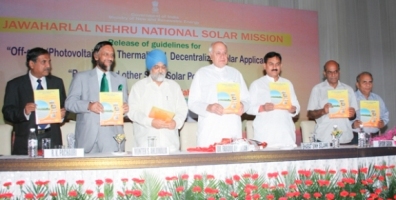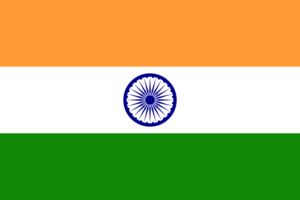India: New Incentive Guidelines for low and medium Temperature Applications
June 28, 2010
Federal Government of India
 On the 17th of June, the Federal Government of India announced a new set of financing guidelines intended for off-grid solar systems under the National Solar Mission. Among other technologies, these new guidelines consider both low and medium temperature solar thermal systems, as well as off-grid PV systems. Photo: MNRE
On the 17th of June, the Federal Government of India announced a new set of financing guidelines intended for off-grid solar systems under the National Solar Mission. Among other technologies, these new guidelines consider both low and medium temperature solar thermal systems, as well as off-grid PV systems. Photo: MNRE
The Indian Ministry of New and Renewable Energy (MNRE) has to fulfil the country’s Solar Mission targets, which calculate with a total of 7 million m2 of installed collector area by March 2013. Current installations throughout the country amounted to only 3.53 million m2 by the end of March 2010, according to the MNRE’s statistics. Hence, the new guidelines for the subsidy scheme which are explained in the attached document have a few improvements and extensions to recent programmes.
First, the subsidy amount per m2 will be 30% of the average costs for the respective system, which will include the costs for the collectors, tank and mounting system. As a result, flat plate collectors receive now a support of 3,300 INR/m2 and vacuum tube collectors 3,000 INR/m2, compared to previous subsidies for social institutions of 1,400 INR/m2 and 1,750 INR/m2, respectively. The following table shows the subsidy amount provided in 2010-2011 for the different solar thermal technologies. The amount will be subject to adjustments according to average market prices of respective solar thermal systems in every financial year. Expenses for installation charges and other additional items, such as civil works, plumbing, external piping, electric motors, valves, blower and drying trays, etc. can be covered by a low-interest loan with a 5 % interest rate. You find more information about the incentive programme in the database of incentive programmes.
| Type of solar collector | Capital subsidy/ Collector area (INR/ m2) |
| Evacuated Tube Collectors | 3,000 |
| Flat plate collectors using a liquid as the working fluid | 3,300 |
| Flat plate collectors using air as the working fluid | 2,400 |
| Solar collector systems used for direct heating | 3,600 |
| Concentrators with manual tracking | 2,100 |
| Non-imaging concentrators | 3,600 |
| Concentrators with single-axis tracking | 5,400 |
| Concentrators with double-axis tracking | 6,000 |
The National Solar Mission’s new subsidy scheme: The subsidy amount for each technology covers 30 % of the average costs for the respective system (see also the attached document).
Second, the subsidy can now be received from multiple programme partners (see the list below). So far, only a selected group of nationalised and co-operative banks had been involved in the national subsidy programme. The following institutions will accept applications under the new scheme for capital subsidies and low-interest loans:
- Indian Renewable Energy Development Agency (IREDA)
- Banks
- Financial Institutions
- Micro-finance Agencies
- Renewable Energy Service Companies (RESCOs)
- System Integrators
- Programme Administrators
The third change in the structure of the incentive programme concerns the extension of the target groups which can profit from it: The new scheme allows subsidy applications from residential home owners, as well as commercial and industrial clients. The solar thermal components used for the systems, however, must still fulfil the norms laid out by the Bureau of Indian Standards. The total budget for both solar thermal and PV off-grid is said to be 10 billion INR in the first year.
Industry stakeholders welcomed the move towards new guidelines, which could definitely help boost the solar thermal market. Nevertheless, the industry also points to the bad experiences they made in the past with slow reimbursements of subsidies. In the residential sector, it is most often the manufacturer or system integrator, who applies for the subsidy instead of the private home owner. The recently founded Solar Thermal Federation of India (STFI) will review the policy and discuss with the officials of MNRE to ensure smooth implementation of the subsidy programme.


